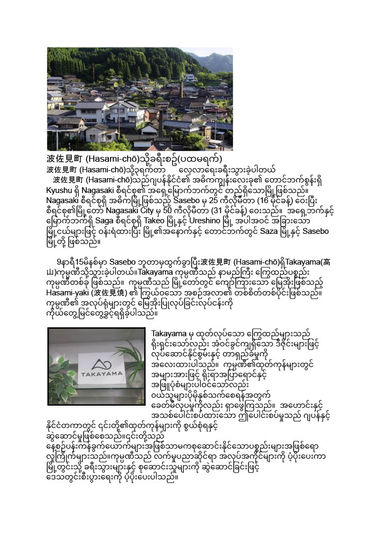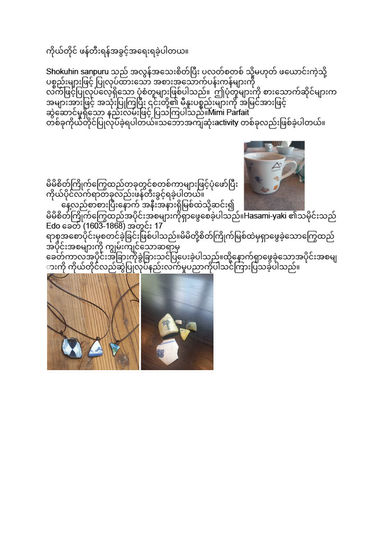This site is available in multiple languages. Please select your preferred language from the bar at the bottom right.
Craft Kyushu | A report from an international student living in Kyushu about the real experiences and excitement of traditional crafts

HNIN OO KHAING
Study trip to Hasami Town
Study trip to Hasami Town (Day 1)

We went on a three-day study trip to Hasami-cho (Hasami-chō). Hasami-cho is a town in the northeastern part of Nagasaki Prefecture, in Kyushu, the southernmost of Japan's four main islands. It is about 25 km (16 miles) away from Sasebo, the prefecture's main city, and about 50 km (31 miles) away from Nagasaki City, the prefectural capital. The town is surrounded by other towns in Saga Prefecture, such as Takeo City and Ureshino City, to the east and north, and borders Sasa-cho and Sasebo City to the west and south.
We left Sasebo Station at 9:15am and visited Takayama Co., Ltd. in Hasami Town. Takayama Co., Ltd. is one of the famous ceramic manufacturers and is part of the rich tradition of "Hasami-yaki", the traditional pottery of the town. At the factory, we were able to see the actual pottery making process.
Takayama's pottery is characterized by simple yet sophisticated designs, with an emphasis on functionality and durability. While the company primarily uses traditional blue and white colors, it also strives to create products that are appealing to consumers, pursuing a contemporary aesthetic. The fusion of good old traditions and new sensibilities is what makes the company's products so popular and appealing both in Japan and overseas.

Takayama pottery is highly valued not only for everyday use but also as a collectible item, and contributes greatly to the local economy by supporting local jobs and attracting tourists and pottery enthusiasts to the town.

I was able to experience making pottery myself and learnt about the differences between the way pottery is made in Myanmar and abroad.
Later that day, I also had the chance to try my hand at making pizza myself. Given Hasami-chō's deep connection to ceramics, I was able to watch a restaurant serve pizza on beautifully crafted Hasami-yaki plates, creating a special dining experience that connected with the town's cultural heritage.


We returned to Sasebo City at 4pm.
Trip to Hasami Town – Day 2
We left Sasebo Station at 9:15 a.m. and first visited the Hasami Museum of History and Culture.
The museum showcases the history of Hasami ware, which has developed over the years, and features historical exhibits as well as contemporary pieces. Visitors can learn about the evolution of the techniques and creativity of Hasami potters over the years. It also includes information on historical events, important people, and the local society and economy, and offers insight into the daily life, habits, and community changes of Hasami townspeople over the years.

The museum displays various historical items such as tools, clothing and everyday life, helping visitors understand the deep roots of the local culture. The building's design combines traditional and contemporary architecture, providing a tranquil space for study and reflection. It is also designed to blend in with the surrounding landscape, enhancing the experience of its visitors.

Afterwards, we also had the experience of making our own "food samples (shokuhin sanpuru)." Food samples are very realistic food models that are generally made by hand using materials such as plastic and wax. They are mainly used to present restaurant menus in an easy-to-understand and attractive way. I made my own "mini parfait" sample, which was one of the most fun experiences I had during this activity.


We also had the opportunity to apply stickers and decorations to the pottery we chose to create our own original pieces. After lunch, we went down to a nearby river to search for our favorite pottery shards (pottery fragments). The history of Hasami ware is said to have begun in the early 17th century during the Edo period (1603-1868). A specialist teacher explained the historical background of the pottery fragments we found in the river, and at the end, we had the opportunity to make accessories using the fragments.



Trip to Hasami Town – Day 3
On the third day of the trip, we left Sasebo Station at 9:00 a.m. On this day, we learned about a technique called "ikomi." "Ikomi" is one of Japan's traditional ceramic manufacturing techniques, and is an important method in the mass production of Hasami ware and many other ceramics. This technique allows for the molding of designs with intricate detail with a precision that would be difficult to achieve by hand. We learned that it is particularly effective when making intricately shaped vessels and delicate products such as teacups and plates.


During the experience, the participants painted the lid of a teacup and poured it into a mold. They also had the chance to paint a cat-shaped molded product, which was a fun experience. Afterwards, they had the opportunity to make "soba (buckwheat noodles)". "Soba" is a traditional dish that has been enjoyed in Japan for centuries and refers to a Japanese noodle dish made from buckwheat flour. It is generally characterized by thin, grayish-colored noodles. The area around Hasami Town is suitable for growing "buckwheat", the main ingredient of soba, and soba culture is deeply rooted there.

Many soba restaurants in Hasami Town take pride in making soba by hand, following traditional methods handed down for generations. We also learned the process of making soba from scratch, boiling it, and cooking it. Through this experience, we were able to gain a deeper understanding and respect for the craftsmanship and dedication that goes into making soba.
This three-day study trip was truly meaningful and fruitful. I was deeply impressed by the efforts and passion that went into how one town has developed from the past to the present. I have resolved to use the valuable experience I gained on this trip to make an effort in my own surroundings as well.


I would like to express my sincere gratitude to the teachers for giving me the opportunity for this wonderful experience and for their detailed guidance and support.
Report
Report language :
Myanmar language





